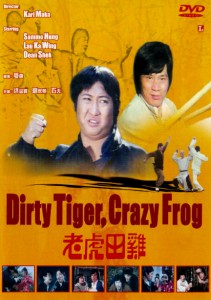Director: Karl Maka
Cast: Sammo Hung, Lau Kar Wing, Chin Yuet Sang, Huang Ha, Chung Fat, Lee Hoi San, Jason Pai Piao, Dean Shek Tien, Peter Chan Lung, To Siu Ming, Cheng Hong Yip
Running Time: 97 min.
By Matthew Le-feuvre
It is no secret that portly legend, Sammo Hung has maintained a keen interest – even a preoccupation – with historical Chinese figures, particularly Leung Yee Tai, Leung Jan, Wong Fei Hung and recently, Yip Man: not solely for their distinct and revered fighting methodologies; but, in addition to character traits commonly inherent often expressing morality, a patriotic code as well a high degree of social upstanding. It was these attributes which prompted Hung too ask questions, to explore what cultivated the inner motivations of a hero (or an anti-hero for that matter); an integral facet he noticed was constantly absent from the Hong Kong film industry as opposed to exacting vengeance on a scale so enormous, believability was abandoned while empathetic audiences cheered loudly at what imagery they viewed without really understanding the core objective or the reasons for their collective enthusiasm. Hung, like Bruce Lee, hoped to change this perspective.
Although it took many years to accomplish, Hung’s eventual desire for flexibility first surfaced in his directorial debut, The Iron Fisted Monk (1977) where drama (or comedy) and graphic violence seemingly walked hand-in-hand, thus the ‘vengeance’ elements were reduced to a secondary (script) unit; a template he was able too replicate time and again for future successes, such as Warriors Two and The Prodigal Son, twin examples of excellent character development in unison with the accurate depiction of Wing Chun Kung Fu.
However, Hung wasn’t just interested in acting, choreography or direction; he was also a pivotal influence in cross-breeding genres: something he easily acclimatized too even if the layman didn’t originally grasp the nature of his cinematic cocktail, blending slapstick comedy with balletic kung fu arrangements and/or fantasy horror. Both, by definition, became the backbone of his repertoire throughout a decade which was slowly waning in terms of box office appeal. Ironically, the cause; in part, was still due to Bruce Lee’s death.
Despite this ripple effect, Hung forged much of his best work during the late 70’s/early 80’s, before a recession collapse: in this instance it was Dirty Tiger, Crazy Frog – an underrated cult oddity which initially saw the triumvirate talents of Hung, Lau kar Wing and actor/director, Karl Maka amalgamating dynamism under their own ‘Gar-Bo’ motion picture standard for an inventive, wacky co-production written by Eric Tsang (Blockhead from the Lucky Stars series), who himself would become an important tour-de-force producer/film-maker after toiling for many years as an unlikely, yet efficient, stuntman.
Indeed, a radical departure from playing formulaic minor supports (Hapkido) or obnoxious villains (Shaolin Plot), Hung stars opposite Wing as the second [of] titular character. Ostensibly, he was more than happy to be a celluloid victim, counterbalancing Wing’s laconic and devious bounty hunter, Tiger – who from the outset is hired by Frog’s elderly domineering spouse to recapture her toyboy husband after he deliberately absconds (to live a lucrative lifestyle) with a priceless heirloom – the invincible armour. Basically, a chain-mail vest designed to withstand blades and spears.
Once the two main protagonist are introduced via a sequence of hilarious set pieces, the madcap premise divertingly focuses on the invincible armour, which itself transforms from being a superficial accoutrement into as much a screen fixture as Tiger and Frog’s inimical relationship or Hung’s trademark self mockery – notably in reference to his weight. Soon everyone from opportunists to lowly criminals (the obligatory Dean Shek in brain damaged overdrive ) desire the armour for their own agenda – including a con woman (Meg Lam) with detachable limbs that has to be seen for pure entertainment value – until the real antagonist, White Crab (Li Hoi San), intercedes ownership of the armour with intentions of subjugating the martial arts world. This scenario forces an uneasy alliance between Tiger and Frog, each creating tactics to disarm Crab of his prized possession… Who will win?!
In spite of harsh criticism, both locally and internationally: Dirty Tiger, Crazy Frog was at the time, a picture that surprisingly took the mickey out of the whole martial arts genre; an alternative angle Maka personally liked to dally around with, especially being NYU educated. His favoured motifs was to parody the contrasts between each characters’ situations in such an opaque manner, the end results always looked refreshing and original even though Maka was directly inspired by western paradigms, not generally recognized nor understood in the east, which is probably why much of his work often appears out of place from the traditional mindset. Nevertheless, ‘bravado’ – an ingredient Chinese audiences were more attuned to in the 70’s, had no relative importance throughout Maka’s sustained idiosyncratic career. It was all about ‘banter’ before ‘brawling’: a nonconformist attitude that attracted both Wing and Hung in consequence to a steady workload of blood, gore and protracted fight choreography.
Verdict: Unlike its follow-up successor The Odd Couple (1979), a weapons-laden masterpiece pre-dating Liu Chia Liang’s Legendary Weapons of Kung Fu (1983): Dirty Tiger, Crazy Frog is a highly imaginative distraction conglomerating Laurel & Hardy-type humour with Three Stooges-influenced physicality.
Matthew Le-feuvre’s Rating: 8/10



